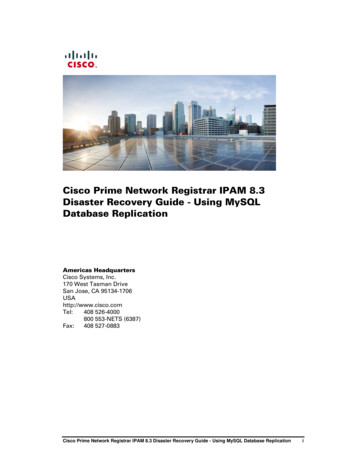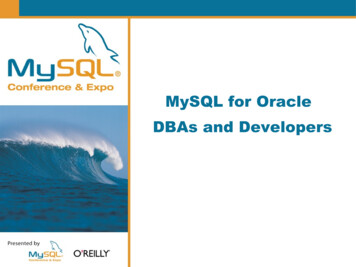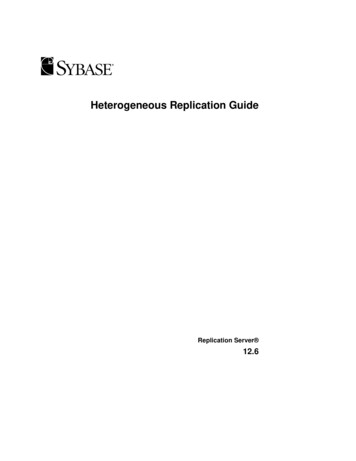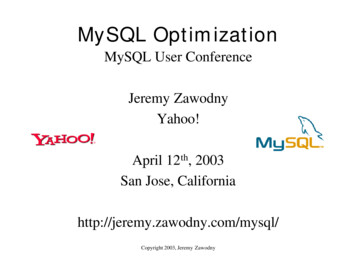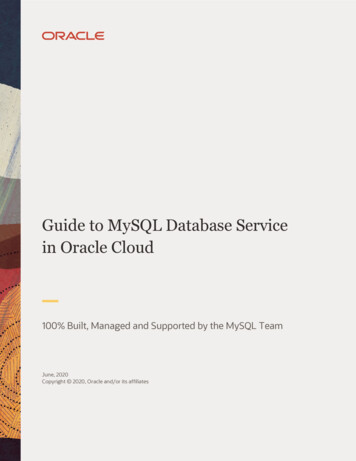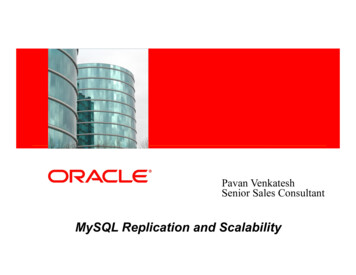
Transcription
Insert Picture Here Pavan VenkateshSenior Sales ConsultantMySQL Replication and Scalability
AGENDA Replication and Scalability basics Read and write scalability options Replication use cases Semi-sync,replication heartbeat Customer success stories Enterprise tools Highlights of 5.5 and 5.6 Q&A
What is Replication?
What is Database Scale-out?Scale-Out is a modern computing architecture that enablesorganizations to improve application performance andscalability on an incremental, as-needed basis by addingmultiple replicated database servers on low-cost commodityhardware.In the online world, many of the largest and fastest-growing companies use MySQLto cost-effectively Scale-Out their successful businesses including Google, Yahoo,Craigslist, Ticketmaster, Wikipedia, YouTube.
Scalability StrategiesScale-up High startup cost Need to scale, big investment, ask forbudget, negotiate, wait. Need to scale again, this is gettingexpensiveScale-out Small startup cost Incremental scaling is no bigdeal, business as usual No limit to scaling Btw, what is "commodity hardware"?- 8 cores? 16? 32?
Considerations for HA
MySQL Replication AsynchronousManual FailoverEasy to setup, configure & maintainVery Popular for Scale OutFast Log shippingCan replicate from one engine toanotherDisadvantages Not true HA - Data can be lost on system failure Complex fail-over/fail-back with more than 1 slave Slaves can fall behind
High Availability & ScalabilityMySQL Replication Native in MySQL Used for Scalabilityand HA Asynchronous asstandard Semi-Synchronoussupport added inMySQL 5.5 Each slave addsminimal load onmasterRelay Log
Building on ReplicationFailure Detection & Failover Linux Heartbeat implements heartbeat protocol between nodesFailover initiated by Cluster Resource Manager (Pacemaker) if heartbeat messageis not receivedVirtual IP address failed over to ensure failover is transparent to apps
MySQL ReplicationRead ScalabilityClientsMySQL ReplicationSlavesMaster Used by leading web properties for scale-out Reads are directed to slaves, writes to master Delivers higher performance & scale with efficient resource utilization
Sharding aka Application ing Logic12345ShardsSlaves
Replication TopologiesSingleChainCircularMultipleMulti - MasterMulti - Circular
Replication use cases
Semi-Sync Replication
Semi-Synchronous replicationTo enable semi-synchornous replication on master –INSTALL PLUGIN 'rpl semi sync master' SONAME 'semisync master.so';–SET rpl semi sync master enabled 1;–SET rpl semi sync master timeout 1000; (1s, default 10s)To enable semi-synchronous replication on slave/slaves –INSTALL PLUGIN 'rpl semi sync slave' SONAME 'semisync slave.so';–SET rpl semi sync slave enabled 1;–START SLAVE;On Master:- Rpl semi sync master status - indicates status of when master is using asynchronous or semi-synchronous replication.- Rpl semi sync master clients - shows how many slaves are configured for semi-synchronous replication.- Rpl semi sync master yes tx - shows number of successfully acknowledged commits by slaves.- Rpl semi sync master no tx - shows number of unsuccessfully acknowledged commits by slaves.On Slave:Rpl semi sync slave status - indicates if semi-synchronous replication is enabled on slave.
Difference between these two types of Replication
Replication Heartbeat"Heartbeat" is a message sent at regular intervals from a master node to the slave nodes.You can configure the heartbeat period. If the message is not received, the slave knows that the masternode has failed. You can now avoid the spurious relay log rotation when the master is idle, rely on anmore precise failure detection mechanism, and have an accurate estimation for seconds behind master.STOP SLAVE;CHANGE MASTER TO master heartbeat period milliseconds;START SLAVE;The following status variables can then be monitored to easily detect when a master is idle and to get a finergrained estimate on slave seconds behind master for recovery purposes:SHOW STATUS like 'slave heartbeat period'SHOW STATUS like 'slave received heartbeats'
Replication Server FilteringWhen Server A is removed from the topology, users can now easily filter any Server A related events byentering the following command on the next server in the calling chain:Server B CHANGE MASTER TO MASTER HOST D .IGNORE SERVER IDS (A)
Replication Slave Side Data Type ConversionsMySQL 5.5 now provides precise data type conversions between master and slave forboth statement-based and row-based operations.Conversions within integer, decimal, string, binary, BIT, ENUM and SET domains aresupported.- SET SLAVE TYPE CONVERSIONS "ALL LOSSY' - enables conversions to typeswith smaller domain (INT to TINY for example)- SET SLAVE TYPE CONVERSION "ALL NON LOSSY" - enables conversions totypes with larger domain (TINY to INT for example)
Replication Flexibility Cluster 1Cluster 2 nMyISAMInnoDBSynchronous replicationwithin a Cluster node groupfor HABi-Direction asynchronousreplication to remote Clusterfor geographic redundancyAsynchronous replication tonon-Cluster databases forspecialised activities such asreport generationMix and match replicationtypes
Booking.com is Europe's largest online hotel travel reservations agencyattracting over 30 million unique visitors each month."Booking.com has been growing significantly every year. That is why we designed a databasearchitecture that we believe will scale up to ten times over our current requirements. MySQL'sopen source structure offers us opportunities for growth and integration because datareplication can be introduced and managed from an early stage."Herald van der Breggen, Senior DeveloperBooking.com
Enterprise Tools
MySQL Enterprise Monitor Single, consolidated view into entireMySQL application developmentenvironment Auto-discovery of MySQL servers,replication topologies Automated, customizable rulesbased monitoring, tuning, SNMP/SMTP alerts Query Analyzer for querymonitoring, analysis, tuning, sourcecode tracing Application Tuning during Dev/QA/Roll out Reduces risk of problems afterapps are deployedA Virtual MySQL Tuning Assistant!
MySQL Enterprise Monitor Deployment
Monitoring Replication
MySQL Enterprise Backup Formerly “InnoDB Hot Backup” InnoDB Hot Backup is rebranded as MySQLEnterprise Backup Online, non-locking backup & recovery– Tables, Indexes– Server, database Incremental backupPoint-in-time recoveryCompressed backupsAlso provides backup & recovery for MyISAMCross-Platform (Windows, Linux, Unix)
Small: Web Reference ArchitectureMySQL Master Single server supporting allworkloads Data replicated to slaves forback-up & analysisMySQL ReplicationMySQLEnterprise MonitorBackupApplicationsAnalyticsMySQLEnterprise Backup Members/Authentication eCommerce Content ManagementSlave 1Slave 2 SearchOnly deploy when future traffic growth is very limited
MySQL 5.5 – Highest Quality Release EverInnoDB becomes default storage engine ACID Transactions, FKs, Crash RecoveryImproved Performance Enhancements in MySQL DB Enhancements in InnoDB 360% over 5.1 on Linux 1500% over 5.1 on WindowsImproved Availability Semi-synchronous Replication Replication HeartbeatImproved Usability SIGNAL/RESIGNAL More Partitioning Options New PERFORMANCE SCHEMAGA
MySQL Product ReleasesContinuous Innovation MySQL Database 5.5 MySQL Enterprise Backup 3.5 MySQL Enterprise Monitor 2.3 MySQL Cluster Manager 1.1All GA now!MySQL Workbench 5.2GAMySQL Enterprise Monitor 2.2GAMySQL Cluster 7.1GAMySQL Cluster Manager 1.0GAQ1 CY2010Q2 CY2010A Better MySQLQ3 CY2010Q4 CY2010
MySQL 5.5 Scales on multi coreSysBench Read WriteGAMySQL 5.5.4MySQL 5.5.3MySQL 5.1AMD Opteron 7160 (Magny-Cours) @2100 MHz64 GB memory2 x Intel X25E SSD drivesOS is Oracle Enterprise Linux with the Enterprise Kernel4 sockets with a total of 48 cores.
The following is intended to outline our general product direction.It is intended for information purposes only, and may not be incorporated intoany contract.It is not a commitment to deliver any material, code, or functionality, andshould not be relied upon in making purchasing decisions.The development, release, and timing of any features or functionality describedfor Oracle’s products remains at the sole discretion of Oracle.
MySQL 5.6 – A Better MySQL.DMDownload!Better Replication Crash-Safe Slaves Multi-threaded Slaves Replication Checksums Time-Delayed Replication Remote Binlog Backups Server UUIDsdev.mysql.com/downloads/mysql
MySQL 5.6:NotOnlySQL: Memcached APIApplicationSQLNoSQL(MySQL edpluginInnoDB Storage EngineDMDownload! Fast, simple access to InnoDB Accessed via Memcached API Use existing Memcached clients Bypasses SQL transformations NotOnlySQL access Memcached for key-value operations SQL for rich queries, JOINs, foreign keys, etc. Implementation Memcached daemon plug-in to mysqld Memcached protocol mapped to the nativeInnoDB API Shared process space for ultra-low latency Additional implementations in future DMs
MySQL Services from Oracle MySQL Support– Global, 24 x 7 support coverage MySQL Consulting–––––Architecture and DesignPerformance TuningHigh AvailabilityMigrationRemote DBAs MySQL Training– DBAs & Developers of all levels– Database and applications– Developing Dynamic Web Applications
ResourcesMySQL Replication ers/mysql-wp-replication.phpMySQL Newsletter - Special Edition: Scaling with er/2010/2010-09sp.htmlCustomer's Scale-out success storieshttp://www.mysql.com/why-mysql/scaleoutRead MySQL 5.5 Replication tion.htmlMySQL Enterprise ers/mysql wp enterprise ready.php
Key Takeaways MySQL is important to Oracle and our customers 5.5 is GA and scales upto 32 cores. Download and test it Use MySQL replication for scale out Use semi-sync for better data integrity Use our Enterprise tools to monitor and backup MySQL Dbs. Need more help?– Purchase MySQL Enterprise– MySQL Consulting
Crash-Safe Slaves Multi-threaded Slaves Replication Checksums Time-Delayed Replication Remote Binlog Backups Server UUIDs dev.mysql.com/downloads/mysql MySQL 5.6 - A Better MySQL. DM Download! Fast, simple access to InnoDB

